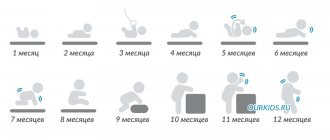Daily regime. Is it needed? What daily routine is optimal for children in the second half of life?
Of course, you need a daily routine. It sets the correct rhythm for the functioning of body systems. But the rhythm of each child may differ from the average book.
In the second half of life, it is important to understand the following: while awake, the child should be cheerful and active, and if he begins to be capricious, then you need to find out the reason.
1.1. The most common causes of moodiness in the second half of life are:
- fatigue (then you need to put him to sleep and lull him to sleep),
- hunger (then you need to feed),
- need for communication (bodily contact, conversation, play),
- discomfort associated with health or the need to change a diaper (the irritating factor must be eliminated).
Knowing your child’s approximate schedule—how much sleep he needs, how quickly he can get hungry—you can choose the optimal individual daily routine for him.
What does a child's daily routine provide?
The point is not only that the child needs to rest, use sleep time to restore strength and process information received during wakefulness, but also that this sets a certain rhythm for the entire body.
- Gastrointestinal tract.
For example, in order to prevent a child from experiencing constipation, it is important that meals are taken at the same time. - Nervous system.
And in order for the nervous system to work effectively, the child must be put to bed at the same time. - Feeding and sleeping schedule.
But how many times a day to feed, how often to put to bed, how long to sleep or stay awake - this is individual. Some people need more time to sleep or several daytime breaks per day. And for some it is less.
Every month, these needs of the child may change, the amount of sleep may decrease, and the intervals between meals may increase. And in this case, it is important to focus not on books or advice from relatives, but on the child’s well-being.
How to organize your child's sleep
Most parents follow the following rules for getting a good night's sleep:
Calm environment
Before going to bed, it is best to turn off the TV and loud music.
Even if your child is used to falling asleep in noise or is already fast asleep, this will still affect the quality of his sleep. For children, extraneous noises prevent them from fully resting. But the main thing is not to overdo it. You should not create a completely quiet environment or walk on tiptoe: in the future, such silence can also lead to problems during sleep. The child quickly gets used to silence. He will not be able to sleep peacefully, and will wake up at the slightest sound.
Time to sleep
Parents need to choose the right bedtime. And, the main guideline in this matter, of course, is the signs of the baby’s fatigue. If they are not noticed in time, then the baby will experience overexcitation of the central nervous system and it will not be easy to put the child to bed.
Daily regime
Children should be put to bed for daytime and nighttime sleep at the same time, set by their parents. This is not only important for the well-being of the child, but also for the well-being of the parents, so that they have several hours of free time every day. But this condition does not apply to children who are sick. During this difficult period, they need care and affection from their mother and good sleep.
Children's room
Comfortable environment in the children's room, maintaining the temperature regime: the temperature in the room should not exceed 23-24 degrees, since children have a very fast metabolism, they will be much more comfortable if the adult becomes a little cool. Also, daily ventilation of the children's bedroom for half an hour before bedtime is the key to a full and quality sleep at night.
Baby food
The child needs nutritious, high-quality nutrition throughout the day. Products must be beneficial for a growing body. Food during the day is the main source of calories; if your baby is full during the day, he certainly won’t be disturbed by hunger at night.
Baby's daytime sleep
During the day, an organized nap is a guarantee of a long night's sleep. Daytime sleep between 12:00 and 15:00 will help your baby fall asleep better in the evening. During this time, the child will have time to play enough and get tired.
Child waking up at night
If your baby wakes up or cries at night, try to immediately respond to his call. Perhaps the child cried in his sleep (got scared) without even waking up. Feeling mother's warmth, the baby will fall asleep again without delay. If a child wakes up poorly, this can be seen by his behavior: he cries, is capricious. It is better for his parents to put him to sleep again, even if he sleeps for a couple of minutes, this time is enough for him to come to his senses and calm down.
Choosing the right sleepwear
Sleepwear should be light, high quality, and as comfortable as possible for the baby. It should not restrict his movements, irritate the skin, and should protect the child from overheating or hypothermia.
Home comfort
Set up a children's room to sleep beautifully and comfortably.
The baby should be comfortable in it. The size of the crib must correspond to the age of the child. Bedding should be made of natural fabrics: soft and pleasant to the touch. Close the windows with curtains so that moonlight or streetlights do not hit the window. You can use a dim, non-irritating night light in a children's room.
By organizing the child’s sleep, parents will create favorable conditions for a comfortable rest not only for the baby, but also for themselves. Some preferences or bedtime rules can already be suggested to parents by their children.
Daytime sleep. How much sleep during the day?
The amount and frequency of daytime sleep should be determined individually. The main criterion here is the child’s mood. If the child is cheerful and cheerful, but does not want to go to bed according to the schedule described in the book or article, then there is no need to insist. But if the child starts to be capricious, then it’s time to go to bed.
Fortunately, the baby’s body itself strives to create a certain individual rhythm of sleep and wakefulness. And if you don’t break, but adapt to this natural rhythm, then even if the child’s regime goes against what is written in the books, the guideline should be the child, and not the average advice.
Daytime sleep is very important!
During the second period of wakefulness, the child is more active, so by the end of it he is very tired. At the age of 1 year and 2 months, it is necessary to provide the child with a second nap lasting about one and a half hours.
According to the recommended daily routine, at approximately 5 pm, the baby wakes up for the evening wakefulness period. If the games were very active, then this sleep can be longer - up to 2.5 hours. However, you should not tighten it even more, otherwise the child will have trouble sleeping at night.
Night sleep. How much sleep at night? To feed or not to feed at night? Should I sleep with or without a night light?
Night sleep is just as individual as daytime sleep. A child is not a doll or a computer. He has his own needs, desires and character. Some children prefer to sleep with a night light, some with music, some with their mother, some with all these “components”, but some don’t care and they can sleep with light, noise, and without a soothing parent.
And here you need to again navigate, “negotiate” with a specific child, and not follow instructions from a book written for the “average” child. There are no “average” ones. Everyone is different and special.
The same can be said about night feeding. At six months, most likely, you cannot do without it. No need to. And closer to the year, perhaps, especially if porridge has already been introduced, you can change the night sleep schedule by feeding the child porridge before bed. Then he may not get hungry at night and sleep without interruption until the morning.
What to do if a child confuses day and night?
One of the most common complaints from parents in the first year of a baby’s life is: “our child has confused day and night.” At night he is awake and during the day he sleeps.
This is not a problem for the child’s health, but it is a big problem for parents, especially if they need to be active during the day, for example, going to work, to the store, or to the clinic.
The only way to cope with this situation is to begin to slowly shift the child’s bedtime. Moreover, you can start doing this either earlier or later, but be sure to choose a clear tactic. For example, start putting your child to bed 15 minutes earlier each time. Then 30 minutes earlier, etc., trying to shift the schedule in a direction more convenient for the parents. After all, parents exhausted from lack of sleep will sooner or later become a problem for the child themselves.
You can “shift” and vice versa - put it to bed 15 minutes later, 30 minutes later, etc.
It is important to choose a constant vector for changes and follow the intended plan, “shifting” the dream either “forward” in time or “backward”.
What should a 12 month old baby be able to do?
The child continues to become more and more interested in the world around him, he is interested in the names of objects and communication with people. The baby is socialized, he willingly gets to know his peers and other people.
By this age, the child has learned to throw toys and objects consciously; he is interested in how far the ball will roll or the cube will fly away.
What should a 12 month old child be able to do:
- Stand on outstretched legs, walk holding onto support. Actively crawl, moving from one room to another.
- Take two small objects with one hand and be able to hand them to mother upon request. Typically, a child will use two hands to grasp a handful of small toys.
- Squat and sit down without assistance.
- Assemble a pyramid, build a tower from cubes. May spend more time alone with himself, playing or looking at colorful pictures.
- Learn new gestures: Many one-year-olds can blow a kiss, wave their arms, and blow hot air.
- Actively copy your parents’ gestures and imitate a conversation on the phone.
- Be able to hold a spoon and try to grab food with it (provided that mom has previously shown how to do this).
- Understand from 10 to 20 words, determine the name of objects that he sees every day. Show with your finger where the cat, book, plate, etc. are.
What else should a 1 year old child be able to do? At this age, the active development of the speech apparatus continues. The baby tries to pronounce some words, although they still only resemble speech. It is worth noting that one-year-old children attach several meanings to the same word.
Until the age of 1 year, the child is closely emotionally connected with his mother, perceiving her as part of himself. At the age of 12 months, the baby’s personality and character traits continue to form. At the same time, the little one is experiencing an internal conflict - the desire for independence and the habit of having his mother nearby.
The child does not sleep well. What to do?
If a child does not fall asleep well, then the following reasons are possible.
6.1. Overexcitement.
This is one of the most common reasons. It is unlikely that an adult will be able to quickly fall asleep after watching a football match, thriller or disco. So is the child. Playing with parents, fear that causes crying, gymnastics and other types of active wakefulness that affect emotions or motor functions interfere with falling asleep.
Therefore, when the time approaches daytime or nighttime sleep, you need to start “turning off” irritants: dim the lights, reduce the amount of noise, perhaps turn on calm music with a slow rhythm. Additionally, holding the child in your arms or rocking him to sleep creates a feeling of safety and closeness for the parent.
6.2. Hunger.
Sometimes the problem of falling asleep is related to hunger. It is difficult to sleep if the body wants to eat.
Eliminating this problem is quite simple - just monitor the interval between meals. It’s good if this period is about 3 hours (for older children - 4 hours).
If a child wants to eat more often, especially when breastfed, then most likely you need to increase the amount of food, add complementary foods, formula, porridge (depending on age). Lack of breast milk, the amount of which is quite difficult to control, is one of the common causes of hunger.
Hunger can also occur if a child is teething and it hurts to eat. Then, after eating a few spoons or drinking a little breast milk, he refuses to continue eating. Simply because he is in pain.
It is important to be able to recognize this reason and smear the gums with “teething” gel in advance, before meals. Then the child will be able to eat fully and will not go hungry.
It must be remembered that the gums may begin to hurt before the emerging tooth is visible to the parents.
6.3. Discomfort (noise, anxiety, light, absence of mother or motion sickness).
Many reasons can cause discomfort in a child and prevent him from falling asleep. Just like adults, a child in the second half of life may be disturbed by noise, bright lights, sharp sounds, uncomfortable position, clothing or bedding, and lack of a sense of security. In addition, an overfilled diaper also does not help you fall asleep.
6.4. Lost routine, lack of rhythm.
It has already been said above that what is important is not so much when and how often you put your child to bed, but whether it happens at the same time or not.
If the child is put to bed at the same time, then the nervous system slowly gets used to this and begins to “switch” to “rest” mode.
If the rhythm is disturbed or does not exist at all, and the child is put to bed, then at “six, then at seven or eight,” this is a sure way to have problems falling asleep.
6.5. The child is put to bed at the wrong time, focusing on the advice of others, and not on the child’s condition.
We all need guidelines, and many parents rely on advice from books, on advice from relatives and friends, on advice from well-wishers on social networks, but forget to focus on the desires and needs of their child.
A child is not a diagram, not a point on a straight line. A child, like all of us, is in a multidimensional world and in order to choose the most successful solution, the right direction, to “hit the bull’s eye,” it is wise to use several landmarks at the same time.
Imagine that your child is a point on a three-dimensional graph, where there are axes X, Y and Z. Then advice from books will set a certain average coordinate for the “average” child of a given age along one axis, advice from relatives - along the other axis, and advice pediatrician specifically for your child - along the third axis. But this is not enough to find the right solution. It is also necessary to make an “adjustment for the wind” - for the individual characteristics of your child. And only then will you have a chance to “get into the top ten”.
At the same time, it is important to understand that the “correction for the wind” can be different every day - after all, the child’s condition, his mood, and the surrounding reality are also different every day.
6.6. Health problems (gas, stomach pain, constipation, runny nose, etc.)
Health problems can also interfere with falling asleep. And these problems do not always require the intervention of a doctor. Sometimes very simple and easily accessible measures are enough.
Runny nose
. You may have already encountered in the first six months that your baby is being prevented from sleeping by a stuffy nose or snot.
The most common cause of nasal congestion in children of the first year of life is narrow nasal passages that become clogged with dust and swell. The reason for this is simple – dry air in the room. Very often, a lack of humidity occurs during the heating season, when it is dry both outside and in the heated room. In order to cope with this problem, it is enough to humidify the air in the room by drying washed clothes or installing a humidifier.
Teething
. The second place among problems with nasal breathing in the first year of life is teething.
Teething can be painful and in itself cause difficulty falling asleep. In addition, when teething, a runny nose may occur, which makes it difficult to fall asleep.
Fortunately, dealing with this cause is also quite simple - just anoint your gums with a “teething” gel. Pain and swelling will decrease, snot will disappear, and the child will be able to sleep peacefully.
Stomach ache
. Children under one year of age are often prevented from falling asleep by abdominal pain. This is not only colic, which usually goes away by the second half of the year, but also gases and feces in the intestines. In this case, gas formation and stool retention may be interrelated. And the first thing to do to solve this problem is to establish a feeding regime. If the baby is always fed at the same time, the activity of gas formation and the risk of constipation are reduced.
Nutrition
A child aged 1 year and 5 months should be fed 4 times a day. The intervals between meals are 3.5-4 hours.
- The first breakfast is an hour after waking up in the morning.
- Lunch – an hour before nap.
- Afternoon snack – half an hour after rest.
- Dinner - an hour and a half before bedtime.
Weakened children with poor appetite receive the same amount of food, but 5-6 times a day. The diet and menu must be agreed with your doctor.
Babies in the second year of life receive crushed and pureed foods. But gradually, as teeth erupt, dishes that teach chewing are introduced into the diet:
- pancakes;
- puddings;
- vegetables and fruits, cut into pieces;
- steam cutlets.
Experts recommend creating a menu for the week at once. The table will be varied, and all dietary requirements will be taken into account. The more products, the easier it is to satisfy the baby's nutritional needs. In addition, monotonous food quickly becomes boring.
The daily ration is distributed as follows:
- lunch – 35-40%;
- afternoon snack – 10-15%;
- breakfast + dinner – 55-45%.
You should take into account the baby's taste preferences: often food that is eaten with appetite brings more benefits.
Causes of poor sleep.
In addition to problems falling asleep, there may also be problems staying asleep.
7.1. Overexcitement.
One of the reasons may be overexcitation, emotions, and frightening dreams.
A child is a living person with his own emotions, experiences and individual electrical activity of the brain. A child has the right to toss and turn in his sleep, to sigh, laugh, and moan. Usually there is nothing wrong with this, but sometimes it should make parents wary, especially if the child actively tosses and turns, moans, grinds his teeth or itches in his sleep. In this case, it makes sense to consult a doctor.
It is important to remember that none of the listed symptoms individually is a sign of any disease. And even when children grind their teeth in their sleep, this may have nothing to do with worms and may even be a variant of normal healthy sleep.
The child’s condition must be assessed holistically, dynamically, taking into account many factors. Therefore, if you are concerned about your child’s sleep, you should consult your doctor. Only a doctor will be able to take into account and analyze the totality of symptoms and decide whether there is a disease or not.
7.2. External factors.
Of course, the reasons for poor sleep can be the same factors as when falling asleep: noise, a full diaper, abdominal pain, hunger, etc.
A 1 year and 3 month old child does not sleep well: what to do?
First of all, don’t panic. Everyone has bad days (and nights), even adults. If most of the time the baby's sleep does not cause anxiety, and frequent awakenings and restlessness occur only occasionally, no radical measures should be taken.
But if a 15-month-old child sleeps poorly, fidgets, cries, and often wakes up on a regular basis, you need to look for the reason. It may consist of:
- feeling unwell - in this case, the baby should be shown to the treating pediatrician;
- errors in organizing the regime: shifting active games to the first half of the day, earlier or, conversely, later going to bed at night will help - depending on how much and when the baby sleeps during the day;
- fear of loneliness: the baby is afraid that his mother will leave him alone. This problem becomes especially acute during weaning or weaning off the pacifier. In such situations, it is important that the mother is within sight or at least audibility while falling asleep;
- unfavorable environment: cold, heat, draft, noise and similar irritating factors. The solution is simple - these factors just need to be eliminated.
In addition, at this age the so-called “crisis of principles” still continues. The psyche, which is learning to build adult communications and understand in a new way the essence of interactions between people, is too excited, and this definitely does not have the best effect on the quality of sleep. There is only one solution here - to wait: the period described is inevitable in the development of personality, but, fortunately, quite short-lived.
Hygiene before bedtime.
Once upon a time, pediatricians recommended bathing children in the first year of life every day, before bed. In principle, you can adhere to this recommendation. But you can also “move away” from it. The fact is that sometimes bathing has a stimulating, rather than a calming effect on children. And instead of falling asleep, they “wake up.” In this case, it makes sense to postpone bathing to the period of active wakefulness, and before going to bed, just wash the child and put on a new clean diaper. The second reason to “neglect” the recommendation of daily bathing is that if the child lives in good sanitary conditions, lies in a clean crib, crawls in a clean playpen, there is no place for him to get dirty. In this case, again, bathing should be considered more as an option for gymnastics and games, rather than as a special hygienic procedure before bedtime. At the same time, sometimes a quiet bath in the bath before bedtime relaxes and calms the child and helps him smoothly go to sleep.
Everything is individual. And the most important thing for parents is to learn to understand this individuality, and not follow the rigid rules of “this is how it should be,” “this is how it is written,” “this is the way it is,” or your own ideas about “what is correct.”
Talk to your baby for advice. Listen to his opinion. This will help you find the optimal solution to any problem.
What routine should a child of the second half of the year have while awake?
When a child is not sleeping, the waking time can be divided into several large periods.
9.1. Spending time on your own.
If the child is in a good mood, then you can leave him “alone” for a while with toys, a playpen, a crib, or a room. Let him explore the world at his own pace, study what interests him and in the way that interests him.
Leaving “alone” does not mean “abandoning.” You can always find a position that will allow you not to interfere in the process, stay out of sight, and, at the same time, keep an eye on the child, insure him and ensure his safety.
9.2. Communication.
Exploring this world and developing a child requires communication. For starters, with parents, brothers and sisters. Perhaps with grandparents. And, if there are any, with pets. Take time for this and fully communicate. Talk, touch, let yourself be touched. This is really important.
9.3. Educational games and gymnastics.
In your daily routine, you need to set aside a little time for active physical and intellectual development. Learn the techniques recommended for your child's age and spend some time on these activities. 5-15 minutes several times a day. This will be quite enough.
9.4. Hygiene procedures.
Use hygiene procedures for communication and development. Swimming is a great way to learn about water, floating and sinking toys, soap suds, temperature, and just for fun.
How and how much does a 16 month old baby sleep?
By the age of 1.4 years, your baby is a real little person: he already confidently walks in different directions, is actively learning to perform actions that require fine dexterity of his fingers, often begins to make friends with the potty and, most likely, speaks a few simple words.
Development at this age occurs spasmodically and at a fairly rapid pace, so it is especially important to properly organize the child’s daily routine and sleep at 16 months. We’ll tell you how to do this right now.
General sleep norms for a 1.4 year old child
In 2015, the American National Academy of Sleep, having studied the opinions of specialists from different fields of medicine who observed young patients for a long time, proposed current standards for children of different ages.
According to these standards, the duration of sleep at 16 months should be 13.5 hours, of which 11-11.5 hours are at night, 2-2.5 hours during the day. The number of daily sleep periods for children of this age varies from 1 to 2, although most often children at 1.4 years old already switch to one day's rest.
You should know that such standards are average and approximate. It is not at all necessary to try to adhere to them with an accuracy of 1 hour: a lot depends on the developmental characteristics, temperament and format of spending time of your child.
Approximate wake and sleep patterns at 16 months
However, it is important to maintain a general daily routine. It has been noted that children of this age feel much better when waking up early - in fact, until the transition to the primary school period, they are all “larks”. Therefore, the optimal time for getting up in the morning is from 6 to 7 am.
Next, the baby’s schedule should look something like this:
- 00-9.00 – hygiene procedures, exercises, breakfast;
- 00-12.30 – games and walks in the fresh air;
- 30-13.00 – lunch;
- 00-15.00 – day rest. If a child’s sleep pattern during the day at 1.4 months involves two periods, you can divide the two-hour period of time into two shorter ones;
- 00-16.30 – awakening, physical exercises, games, classes;
- 30-17.00 – afternoon snack;
- 00-19.00 – second walk on the street;
- 00-19.30 – bathing, massage and other hygiene and health procedures;
- 30-20.00 – spending time with family, reading, quiet games, communication;
- 00-20.30 – dinner;
- 30-21.00 – preparation for a night’s rest;
- 00-7.00 – sleep.
Thus, the duration of a baby’s wakefulness at this age can reach 6 hours without the slightest damage to his well-being.











